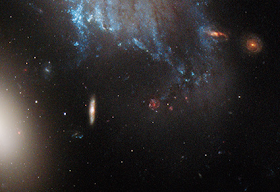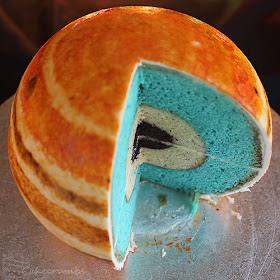at a distance of 3.4 billion light years lives a very excited system known as the bullet cluster. the image below shows the cluster - lots of galaxies speckled throughout, two clumps of hot x-ray gas shown in red, and two separate regions of blue that represent dark matter.
the bullet cluster is actually two separate galaxy clusters, caught in the act of intergalactic intercourse - they are merging together to become one. the separation of the two red and two blue clumps is evidence that the clusters have just slammed together.
when the clusters pass through each other the first time, the gas between the galaxies kinda slams together, heats up to very high X-ray temperatures and slows down to stay more centrally concentrated. the dark matter does not heat up due to this thermodynamic friction and instead passes through more easily without as much slowing. so the red and blue blotches are separated.
a team in germany decided to use computer models to simulate this process and guess what they found? thats right - dirty space news!
they took two clusters of galaxies and allowed them to come together, checking the effects when using clusters of different size ratios.
in the image above, you can see a map of how the hot gas spreads during the encounter. the authors point out that "a top-down inclination of the plane of the encounter ... does not produce drastic changes in the morphology of the bow shock or of the edge of the bullet." this has not been my own experience, but to be fair, my work is not yet published.
 |
| the bullet cluster: interacting galaxy clusters (credit: link) |
the bullet cluster is actually two separate galaxy clusters, caught in the act of intergalactic intercourse - they are merging together to become one. the separation of the two red and two blue clumps is evidence that the clusters have just slammed together.
when the clusters pass through each other the first time, the gas between the galaxies kinda slams together, heats up to very high X-ray temperatures and slows down to stay more centrally concentrated. the dark matter does not heat up due to this thermodynamic friction and instead passes through more easily without as much slowing. so the red and blue blotches are separated.
a team in germany decided to use computer models to simulate this process and guess what they found? thats right - dirty space news!
 |
| Credit: bullet cluster simulations (pdf) |
in the image above, you can see a map of how the hot gas spreads during the encounter. the authors point out that "a top-down inclination of the plane of the encounter ... does not produce drastic changes in the morphology of the bow shock or of the edge of the bullet." this has not been my own experience, but to be fair, my work is not yet published.


























